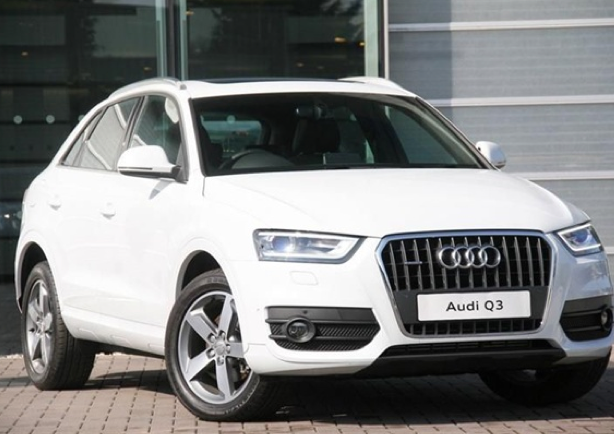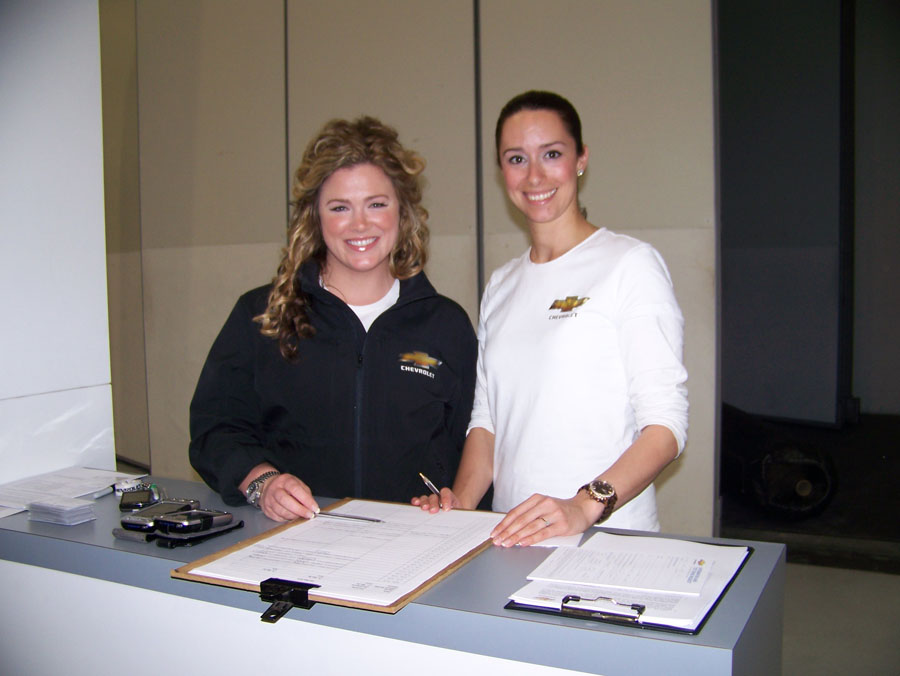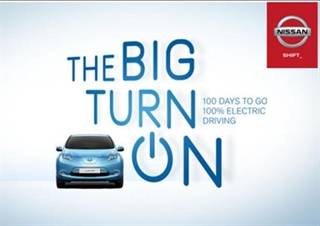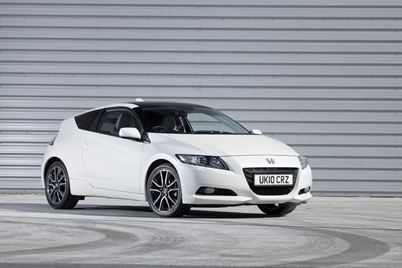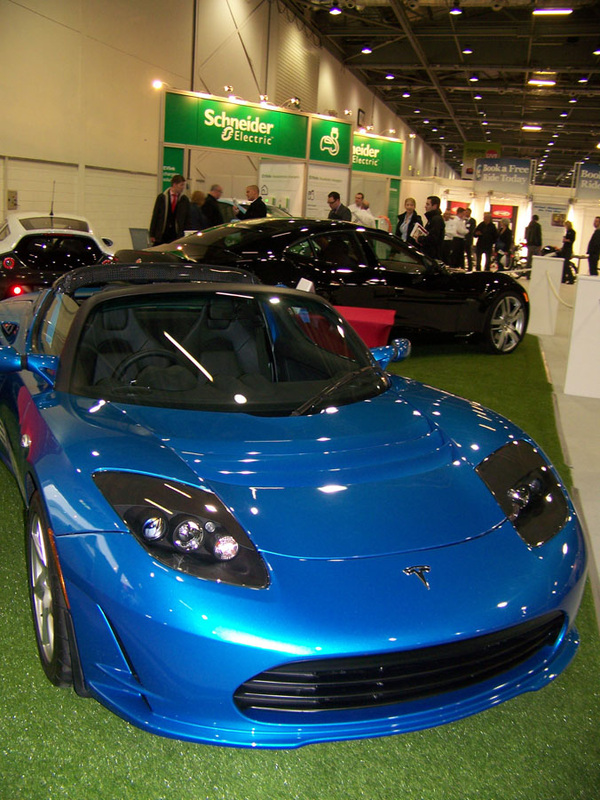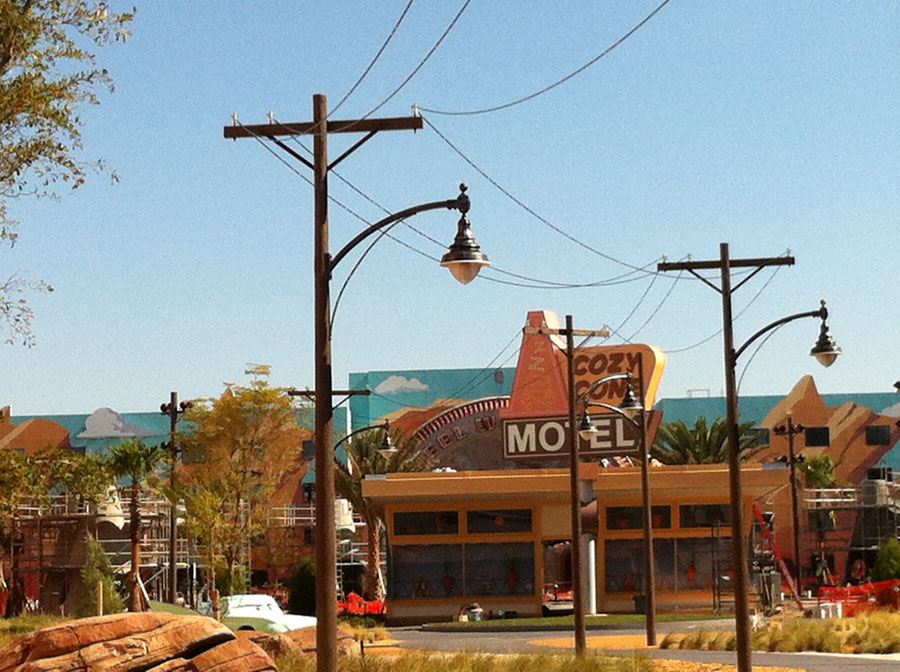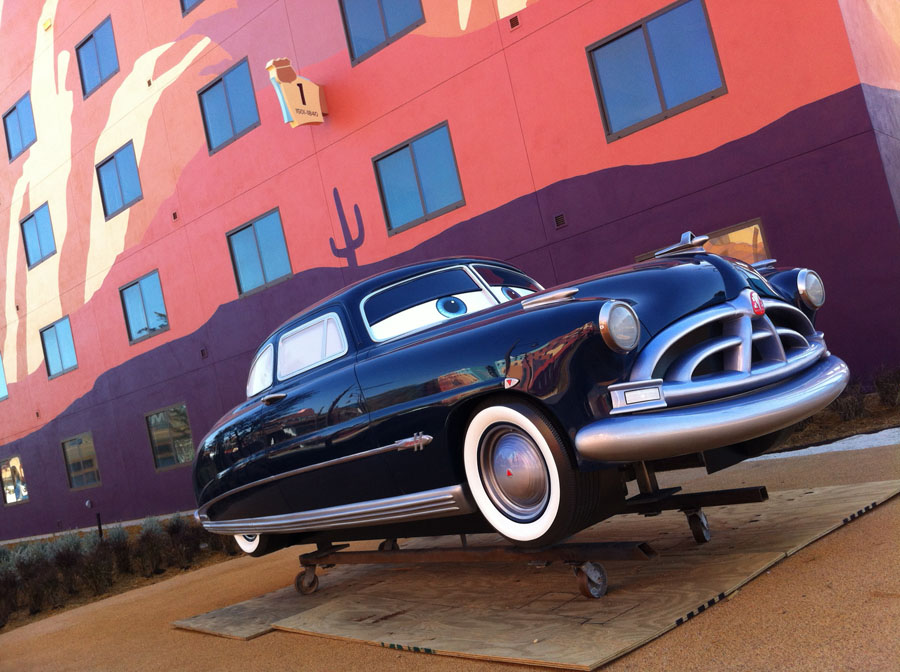TOP STORIES
Driving the Mazda CX-5
Aussie aside
Over dinner, I detected that our attentive waiter, who is very knowledgeable about wine, how to eat cheese and the best way to enjoy porridge, was not local. (We think he slept under the table; he was there last thing and there again at breakfast.)
Turns out he comes from a little place called Echuca, near Melbourne, Australia, 40 minutes from where my grandparents Fred and Beatrice Turner farmed from 1925 to 1936 (at Girgarre near Kyabram). I could have fallen over backwards. It was great to hear more about the place. My father has written an excellent book about our Essex family moving to Australia, then coming back again, including my grandad’s service for Australia at Gallipoli in the first world war. It’s on my list of things to do to get it published. Contact me if you’re an interested publisher or if you know the area! Should Lorax advertise SUVs?
In the States, the CX-5 teamed up with The Lorax movie, provoking an organisation called Rethinking The Automobile, to circulate a petition to 'Protect The Lorax' from commercialisation.
The spokes creature for the campaign, the Henson-created Zozo said: "The Lorax speaks for the trees, not the SUVees! I urge Universal, Mazda and their partners to immediately remove from circulation any and all advertising that uses Dr. Seuss' character The Lorax to promote and sell automobiles." He's right that the association is pushing it a bit. If we really want to bring the truffula trees back, we probably all have to take up cycling or at least drive a smaller car. Being realistic, though, an efficient crossover is much better for the planet than a gas-guzzling one. |
Mazda’s CX-5 compact crossover is not a hybrid. I was lucky enough to be invited to drive it in Scotland and find out why.
Day 1 2pm my Easyjet flight arrives at Inverness When a new car arrives, PRs need to get as many journalists as possible to drive it and spread the word in a short time. The easiest way is to ship groups of scribblers to a fleet based somewhere near some decent roads. To make life more pleasant for everyone, and to lure the busiest and most-read reviewers, that’s usually somewhere rather nice. Does it affect our view of the cars? We hope not, but we are only human. In days past it used to be that the worse the car, the more exotic the location. I’d probably end up hating any car I’d only driven around Luton. Our small group was met by the genial Peter Frater, an ex-motoring journalist and the PF in PFPR, Mazda’s PR agency. PF and his lovely Geordie wife Denni know how to achieve a good work/fun balance on a driving trip. The plan was to load the three of us on this flight into two cars and drive to the Torreden in Wester Ross. The hotel was programmed into the optional Tom Tom sat-nav with Google live search, displayed in a large display top centre in the dash. However our group had arrived too late for the lunch stop, so Peter suggested a detour to grab some food at a seafood bar. He said ‘keep going you can’t miss it’, so we didn’t listen too hard to the rest. I paired up with Zog Ziegler, whose well- rounded tones you may have heard on various BBC Radio programmes, or you may have read one of his numerous columns. His father was a pipe-smoking, Jaguar-driving spy (our side) who called his son Zog and then sent him to prep school. Strangely, unlikely the Boy Named Sue, Zog didn’t try to shoot him. But, with such a start, it doesn’t come as a surprise that he’s always good for some entertaining anecdotes and scandal about well-known personalities. It’s hardly surprising, too, that within half an hour we were hopelessly lost, along with the hapless Reg who had opted to follow us. As all the information the three of us had managed to absorb was ‘blue and white hut on the side of the road by the loch’ wasn’t on the map or in the nav, we stayed lost for some time. This did, at least, mean I got the drive the 4WD 2.2 turbodiesel CX-5 down some windy one-track roads lined by bright yellow gorse and dark, craggy rocks. As a crossover rather than a true off-roader, the Mazda wouldn’t be able to keep going over the rocks if we’d run out of road completely, but the four-wheel drive gripped the rough, damp road with confidence and the diesel engine hauled us easily up and down sudden switchbacks. The steering is light, but it gave lots of feedback to tell me what the wheels were up to. I was finding the CX-5 a pleasant place to be, too. The seats are comfortable and the quality of materials and fit and finish are good, with just enough shiny bits to make it look and feel smart. 4.30pm Tea and tartan Reg was about the pass out from hunger so we stopped at the Lochcarron Weavers tea room and shop. The Mazda’s rear visibility isn’t the best, but I used the rear-view camera to reverse into a space. (The wing mirrors do the job well enough if this isn’t fitted). I thought I’d stalled as all went silent, but the idle-stop system had switched the engine off as soon as we stopped moving to save fuel. The amount saved could be considerable if you’re stuck in a stop-start jams or on a route where you catch every red light. You just put your foot back on the accelerator to move off. The lovely ladies of the Lochcarron Weavers were closing the tearoom, but took pity on us and served up wonderful cakes. We also got to browse through the sporrans and tartanabilia. 5pm The reason we came here The next stretch of road was a driver’s dream, looping along the side of a glowering mountain. It’s a pity the word awesome can now be used to describe a youth with spots. This landscape was awesome. Talking of words, I’ve learned from reading automotive press packs that the Japanese language has an awful lot of them. They have words that mean things like ‘the sensation of rolling down a hill wearing only your socks’, or ‘the feeling that you’ve forgotten your kazoo’. The CX-5 apparently has elements of KODO design, meaning Soul of Motion. Whatever. I was more pleased to spot the phrase Jinba Ittai in the literature. This has been used since the Mazda MX-5 was first conceived to describe a driving experience like the ‘oneness of horse and rider’. Duplicating the fun of driving a seat-of-the-pants roadster in a tall, bulky crossover vehicle is like your auntie trying to move like Jesse J, but Mazda’s engineers were aiming to get as close as they could. The result is pretty impressive. On fast corners, SUVs can feel disconcertingly like ‘jello on springs’ as Geraldine said in ‘Some Like it Hot’. The CX-5 clung on with minimal roll, and that muscular diesel gave me plenty of confidence to get past dawdlers before the next bend. The engineers have also used the MX-5’s short, fast gearchange as an ideal target, and the CX-5’s six-speed manual gearchange is light and quick, although without the precision of the very best. We couldn’t prise Reg out of the automatic to have a try, but he said it was excellent, particularly in Sport. This is Mazda’s first automatic box in a diesel and the company claims it feels like a manual. (Without all that annoying manual changing.) My only real complaint was wind and tyre noise at speed, particularly on the motorway to and from the airport. That would get tiring. All in all, of course I would have rather driven that marvellous road in plenty of other cars including a BMW 3-series, but if you want/need a crossover, this one is fun. 6pm Head for the barrier, don’t brake! As we drove up the drive of the gorgeous Victorian hotel called in boutique style The Torridon, a little game was waiting for us. I had to head for a barrier at 10mph then take my feet off the pedals. I chickened the first time, but on second attempt, the standard Smart City Brake System activated the anti-lock brakes and we juddered to a halt just before impact. This system is designed to save you if you get distracted in a traffic jam (maybe you’ve spotted a celebrity without make-up). At 10mph, it will stop you before the impact, any higher and it will minimize the damage and the repair costs. It would be useful in a typical traffic jam caterpillar-effect fender bender, but it’s not as impressive as the Mercedes’ Pre-Safe system that brakes for you at speed to avoid an accident. We dug our bags out from the back of the large loading area and headed up to our suites overlooking the loch, a mountain and wandering highland cows. 7.30pm Handing round the pistons PR Director Graeme Fudge hosted a press conference to answer the most obvious question. Why isn’t the CX-5 a hybrid? Mazda has always been an innovative company. It’s persevered for years with the rotary Wankel engine, which now powers the sexy RX8 and became the first Japanese manufacturer to win Le Mans, with the rotary-engined 787B in 1991. It also gave us back the affordable roadster with the MX-5 in 1989, when no one else had the guts to do it. Rather than following the herd, the team at Mazda has been doing some long-term thinking. SKYACTIV technology is about making the car as light and fuel-efficient as possible rather than simply bolting on lots of heavy hybrid kit. So in 2008 the company set a target of increasing the average mpg of its fleet by 30% by 2015. The SKYACTIV label covers work to lighten and improve every part of the car. More light, strong, tensile steel is being used. (The proportion has gone up from a typical Mazda’s 40% to 60%.) We got to hand around two sets of pistons. While tuners usually concentrate on shaping the combustion chamber to swirl fuel around the spark plug, Mazda has changed the game by making pistons with little well in the centre to act as a little bath of fuel to dunk the plugs and create a much bigger, more efficient bang at epic compression. To illustrate just how epic, the compression ratio of 14.1 is higher than that for a Ferrari or F1 car. We could feel the difference between the lighter new pistons for the diesel engine and those from a previous Mazda. The entire engine is made out of light alloy, with a new two-stage turbo. The compression of 14.1 is low for a diesel, but detonation is earlier than usual to make the most of the stroke. This engine achieves 20% less emissions and carbon dioxide emissions. It also meets tough Euro 6 emissions regulations without the need for after treatments. (One way to reduce nitrous oxide emissions is to use a urea solution called AdBlue as an additive) Electrification will come, but gradually. The CX-5 already has idle-stop. The next step, due in a couple of years, will be regenerative braking (like KERS in F1) to recoup energy from the braking to power electric functions including idle-stop stop. A hybrid will come later when technology and the number of charging points has improved. Graeme says the aim was “A car for everyone, we wanted to create a more environmentally friendly car without compromising on driving pleasure.” 8pm Whisky and sex Next came dinner before some of us retired to the whisky bar. This is whisky country. There was a decanter of whisky in my room, I had whisky and cream on my breakfast porridge and, just as Vegas has slot machines in the airport, Inverness has a large whisky shop in the departure lounge. The Torredon has 350 different malt whiskies and numerous fancy gins. Going to bed early would be downright rude. The Cardhu was delicious. While Reg played the piano, Denni and I found ourselves joining in (not leading) a hilarious conversation I would have expected on a girls’ night rather than with a bunch of hardened motoring writers. It ranged from Keanu’s tragic loss, to dealing with teenage daughters, whether internet dating is a good idea and whether sex was the essential basis of marriage. Great stuff. Other tangents on the way included tracing your ancestry and that programme now forever called Who the Fuck Do You Think You Are? and a pipe tobacco called Babies Bottom (as smooth as), but referred to by Zog’s dad as Kid’s Arse. We even had that conversation about the name of the cabin boy in Captain Pugwash. For future pub discussions, let me assure you it was Tom. Day Two 10am trying out the petrol Zog and I headed back to the airport in the petrol model. I was keen to try this because it will be the version sold in the US. I have to say it’s really time the Yanks got over their diesel phobia. This petrol was quiet and comfortable on the dual carriageway, but pretty gutless, needing a downchange on upward slopes. If you want a roomy, fuel-efficient crossover, I’d say give it the CX-5 a test drive. You may have to wait, though, the cars in the US sold out quickly and I heard a whisper those 4,000 heading for the UK are going like cupcakes. |
Figures
The range
CX-5 range has 18 models priced from £21, 395 to £25,895 · Available with the choice of 2-wheel or all-wheel drive · Best in class CO2 emissions of 119g/km and outstanding combined fuel economy of 61.4mpg · Choice of six-speed SKYACTIV-MT manual and SKYACTIV-Drive automatic transmissions Best sellers:
Petrol: 2.0-litre SKYACTIV-G 165hp £21,395 Diesel 2.2-litre SKYACTIV-D turbodiesel 150hp or 175hp £22,995 to £25,895 These are expected to account for 85 percent of UK sales. The 150 has plenty of oomph for most people. Cost comparison
(Photos are not exact models) Mazda CX-5 2.2 2WD SE-L Nav 150hp £23,395 61.4mpg combined, 119g/km CO2, road fund licence 1 year £0, monthly BIK (20%/40%) £66/£132
Audi Q3 2.0 TDi 2WD SE 140hp 54.3mpg, 138g/km CO2, road fund licence 1 year £120, BIK (20%/40%) £78/£156
Ford Kuga 2.0 TDCi 2WD Titanium 140hp £23,645 , 47.9mpg 154g/km CO2, road fund licence 1 year £170, monthly BIK (20%/40%) £94/£187
Kia Sportage 1.7 CRDi 3 Nav £23,190 52.3mpg, 143 g/km CO2, road fund licence 1 year £135, monthly BIK 20%/40% £84/£169
VW Tiguan 2.0 TDi 2WD SE 140hp BlueMotion £23,900, 53.3mpg combined, 139 g/km CO2, road fund licence 1 year £120, monthly BIK (20%/40%) £86/£171
|
Ecovelocity - London's green motor show May 5-13 2012
I had great fun at Ecovelocity, talking to people who were looking to try or buy a greener car and the exhibitors and taking the opportunity to drive a few of the best known electric cars.
Held at London’s ExCel centre, this green motor show included some sexy-looking frugal Citroens, a protoype hydrogen fuel-cell minivan from Vauxhall and a number of small, light and economical petrol models. It’s main focus this year, however, was electric cars.
Held at London’s ExCel centre, this green motor show included some sexy-looking frugal Citroens, a protoype hydrogen fuel-cell minivan from Vauxhall and a number of small, light and economical petrol models. It’s main focus this year, however, was electric cars.
|
Be aware of some strangeness in the GM marketing plan. The Vauxhall Ampera has 24 specialist dealers, while its American cousin only has two, and I was told that Vauxhall dealers will not service the Volt.
As the cars are mechanically identical, the figures quoted for the Ampera in the show guide should apply to both cars. The cars look like twins inside and out, apart from the front grille and badging. Power: batteries, generator powered by 1.4-litre engine Top speed 100mph 0-60mph under 9sec Combined fuel consumption 235.4mpg Battery warranty: 8 years, 100,000 miles Range: battery 50 and generator 300 miles Chevrolet Volt Price £25,000 to £34,995 including Government grant Cars warranty: 5 years, 100,000 miles www.chevrolet.co.uk Vauxhall Ampera Price from £32,250 including government grant Warranty: lifetime, 100,000 miles www.vauxhall.co.uk-ampera.co.uk Nissan is running a Europe-wide competition to win a Leaf called the Big Turn On
Call 0845 200 8000 See www.nissan.co.uk Nissan Leaf Price £25,990 (including government incentive) Engine: electric motor Warranty 5 years, 60,000 miles for car and battery Range 109 miles Top speed 90 mph Honda CR-Z
Price £18,035 to £23,080 Engine: 1.5 plus electric motor Economy 56.5mpg Warranty 3 years, 90,000 miles |
Driving the Chevy Volt
I’ve got a soft spot for the Volt – I first saw it as a concept car at the Detroit auto show. Its skeleton was also on display: a flat ‘skateboard’ with battery modules like so many CDs stacked along its central spine.
The form of propulsion used by the Volt and its European twin, the Ampera, is known as Extended Range Electric. The wheels are always turned by an electric motor. Sometimes the motor is powered by the battery stack, or by a generator. The generator, in turn, is powered by a small, 1.4-litre petrol engine. You power up the Volt’s batteries by plugging it in at home or at a charging station, and that will give you 50 miles. But if you need to go further, you can fill the tiny tank at a petrol station and head for Scotland using the generator. The generator does put some power into battery, and regenerative energy recouped when you brake (as with KERS in F1), but the battery is intended to be fully charged up from the grid. GM says this is because it doesn’t want the car to waste energy or use petrol when you don’t need to. This was the first time I’d seen the Volt in the metal and it’s handsome, as was my minder, the professional GT and sports car driver Bradley Ellis. (see www.bradleyellisracing.com) All the patient chaps sitting in were professional drivers who would be able to grab a steering wheel or pull on a handbrake to get a driver out of an accident. Bradley explained all the tech and showed me the electric plug socket on one side of the car and the petrol filler on the other. I threw my stuff in the back and found a reasonable load area, although it’s small for the size of car. The interior is quite flash, with stitched leather seats and black and white swoopy trim like the markings of an orca. The central stack and door inserts are plastic that’s proud to be plastic, like an Eero Saarinen pedestal chair. The buttons are simply touch-sensitive dimples. The rear has just two captain’s chairs, with the battery compartment running through the centre. You do get some cupholders in between the seats, though. A large central screen could show sat-nav and all the usual infotainment (it has Bluetooth and all that jazz). Or we were looking at a sci-fi style graphic fading in and out the bits that are working at any time to make the car move. If you don’t want to know, you can turn it off. Simpler gauges on the dash to show you how much power your have in the battery or how much petrol in the tank. To start, I pressed a button, selected Drive with a stubby ‘gearlever’ and we eased silently and smoothly on to the road. The Volt felt very comfortable and somewhat executive. Really it needs to at this price. Chevrolet quoted £29,995 including Government grant for the car I drove. Because electricity is either on or off, the power is available instantly. It didn’t feel particularly sporty, but it had plenty of pull for overtaking and I found myself going too fast because there was no warning from rising engine revs. This is the weirdest thing about electrics. We’re used to hearing engine notes rise, telling us to change up a gear, or as the auto does it for us. Even CVT (Continuously Variable Transmission) automatics usually have steps programmed in to make people feel more comfortable, but in the Volt the sound remains level – and it’s mainly road or wind noise that’s usually competing with the engine growl. We drove half way round the 3.5-mile test route in electric mode, then back again on the generator. Then I could hear a slight growl from the engine, but the feel of driving remained the same. I like the idea that you can select your mode. So if you’re heading up the motorway to a town, you can choose to drive on the generator first, then use the electric power around town. We parked using the camera – a useful addition as rear visibility isn’t great. I got out impressed. This car is bulkier than the concept, because it had to do everything a conventional car does, and as a result the 1.0-litre engine had to grow to 1.4 litres. It’s still very clever, and demands no sacrifices. That’s its main USP. Driving the Nissan Leaf
The Leaf is an icon: it was the first electric car that aimed simply to be a useable, everyday family car and it’s had praise and awards showered on it.
I’m not enamoured of its looks, or the rather plasticky interior, but neither are offensive and it’s a genuine five-seater, unlike the others I drove. This is a 100% electric car; you can plug it in at home or at a public station using a surprising small adaptor to a three-pin plug. Its battery is made up from 48 modules with four small batteries per module, so they could be replaced in sections, or even repaired. At the moment no one really knows how long they’ll last, but it’s likely to be more than 100,000 miles. There’s a gauge on the dash that tells you not only how much charge the battery is holding, but how healthy the battery is – useful if you’re either buying or selling a used Leaf. I had come up with the image of the autumn of your relationship with the Leaf, but just can’t fit it into the previous sentence. To start the Leaf, you push a button and it sounds a little chime to let you know it’s on. (I liked that) The gearlever is more of a knob (for a door, not Carry On jokes). You nudge it once for normal Drive, or twice for super economy. As you drive, a little tree grows branches on the instrument cluster to tell you how economically you’re driving. I grew three branches – I know road testers on certain magazines who would aim to produced a blasted oak. It’s pretty sprightly, and I found myself well over the limit again without realizing. It’s smooth and quiet, but manages to be surprisingly engaging to drive. I liked it, I think I could develop a personal relationship with it. As with the other electrics, the wind and road noise seem loud with the usual engine roar. The unusual finned headlamps were designed to reduce the racket created by wind over the door mirrors in prototypes. Even if I could afford one, however, it wouldn’t work for me. Even with a range of 109 miles, My husband wouldn’t be able to use it to commute to work unless he could find a public charger somewhere near his work. It would probably be a fast charger, too, so he'd have to wait for 20 minutes while it recharged. More fundamentally, we don’t have a drive or a garage, so plugging it in at home would involve an open window and a lead trailing across a neighbour’s garden. Living in a terrace, or a flat would be a challenge, too. Driving the Honda CR-Z
I wanted to drive the CRZ because I liked the promise of sporty looks and performance with shopping-car fuel consumption.
This car has the power of a 1.8 because its 1.5 engine is always boosted by an electric motor. You can’t drive it in purely electric mode. As it’s the petrol engine that powers this hybrid, the interior is pretty conventional, and you change gears in the normal way using a nice light gearshift. It did feel nice and sporty, but it’s very noisy. Honda engines are always revvy, but the road and wind noise were annoying. The back seats are for contortionists only and the load space is tiny. So, yes it’s nice, but I don’t want one. Thanks to Honda for the press photographs (I) like Lightning
One stand close to the entrance usually had a gathering of chaps - the eye-candy stand, featuring the Tesla, Fisker Karma, Delta Coupe and my favourite, the Lightning GT.
This is probably as close to an electric E-type as you're going to get. The Lightning is all-electric, but can charge in 10 minutes and has a range of more than 150 miles. It will be built in Coventry by the Lightning Car Company, which quotes a less-then 5 seconds 0-60mph and a recommended top speed limit of 125mph. Spec and colours will be announced this year, so it's getting close to production. I haven't got a price quote, but it's not going to be cheap. See www.lightningcarcompany.co.uk |
Ampera driver
Charlie Roberts has just taken out a lease on an Ampera. As Marketing Manager of Zero Carbon World, he wanted to drive an electric car, but frequently has to make long trips for work. He’d previously enjoyed driving an Audi and a BMW as company cars, so he was pleased that he could still enjoy an executive experience with the Ampera. “ I came to work for the charity because I wanted to make a difference, but it’s great to be able to get something that’s quite nice to drive.”
He says “I think driving an electric car makes you a more careful driver, you have to monitor the range and try to get an much as you can from the car. “ Charging wars
I was amused to see a bit of needle between the stands at Ecovelocity. Most were for private charging point networks, including Source London.
Most require you to purchase a smart card, but the stall for Zero Carbon World had a big banner staying ‘Say no to the smart card!’ Communications manager Mark Chatterley explained that this charity’s benefactor Kevin Sharp, drives a Tesla, and it irks him that electric car drivers could potentially need a wallet full of smart cards. He is donating 1,000 charging stations to places such as hotels and B&Bs simply to encourage people to own and drive electrics. Mark says the plan is to get slow chargers where they are needed, so other organisations can get on with the fast chargers. Points are also spreading across the UK as supermarkets are putting in points to attract customer. I was surprised to see on Mark’s map that one of the best-covered areas is Wales. That’s thanks to a firm called Welsh Road Trips, which is helping to put in stations. As there are some excellent driving road in Wales, this is very good news. Nissan Leaf owner
Mark Chatterley loves his Leaf. He says: “I’m into technology and to me it’s a big gadget on wheels – my extravagant purchase. I love the simplicity of it.” So far the range has not been a problem because the furthest he tends to drive on a regular basis is 65 to 70 miles to visit family, so he stays the night and charged up before coming home. He loves the fact that he can set his Leaf to charge and it sends him an email to tell him when it’s finished. (He’s put his phone on silent the second night.)
In fact, you can program the Leaf to start charging when the electricity is cheapest if you have that kind of tariff. A full charge will take nine hours. He says “The offer of a free fast charger would make me choose between one supermarket and another.” Why buy an electric car?
Are electric cars green?
I had a long conversation with a delightful couple, she was all enthusiastic about the cars here, he wasn't. Archie (not his real name) had worked for Shell for 40 years, 27 of those in development and had seen many good ideas fail due to cost. His question is, where will all this electricity come from? He said: "The shadow of these vehicles is just as bad as petrol, because you have to generate electricity and at the moment it's all coming from French nuclear power stations."
|
Disney's Art of Animation resort
Lightning McQueen, Tow Mater and all your favourite characters from Cars are waiting to meet you at the new Art of Animation resort at Walt Disney World, Orlando, opening June 18.
I joined a group of journalists being shown around in April, when only the Finding Nemo wing was complete, ready to open May 31. However, I persuaded some nice chaps to give me a hard hat and high-visibility jacket to take some of the pics of the almost-finished Cars wing. (Thanks to Disney for the press photos showing interiors with families.)
We could see some cute cubs over in the Lion King wing (August 10). The Little Mermaid follows September 15.
The new resort aims to put guests right into the movie. The lobby takes you through the creative process, so as we walked in to be greeted by King Neptune and some giant sea creatures, one wall was covered in early sketches, another with fabulous character drawings. A chandelier overhead was made of animation storyboard sheets; the restaurant is decorated with landscapes, and the shop is full of giant paint pots. As we stepped outside, the hotel blocks were painted like enormous back drops, and ‘life’-sized characters were everywhere.
I don’t have kids, but I was looking through the eyes of my two nieces, Rosie, 6, and Ellie, 4. They would (will) love it. Some of the established resorts are beautiful, but the connection to the movies is more subtle. There’s nothing subtle here: you’re there, in the ocean, in Africa, or in Radiator Springs. In the Nemo pool, the kids can hear the voices of Nemo, Dorey and Marlin. (I wouldn’t – I can’t bear putting my face in the water.)
In the Cars wing, a freshly laid road leads to the Cozy Cone Motel, with its pool and cone-shaped cabanas. Inside, the designers have had a ball introducing whimsical details. The Cars rooms have cone motifs everywhere; the Nemo rooms have bubble-shaped overhead lights and jellyfish lamps.
Art of Animation is one of the more affordable resorts in Disney’s 40-square mile fiefdom. Rates are from $248 per night, including free transport to and from the airport and extra hours at the theme parks. Family suites include two bathrooms, a kitchenette and three separate sleeping areas that can sleep up to six. Standard rooms sleep up to four.
* Later in the year, Carsland opens at Disneyland, California, with rides based around the characters.
I joined a group of journalists being shown around in April, when only the Finding Nemo wing was complete, ready to open May 31. However, I persuaded some nice chaps to give me a hard hat and high-visibility jacket to take some of the pics of the almost-finished Cars wing. (Thanks to Disney for the press photos showing interiors with families.)
We could see some cute cubs over in the Lion King wing (August 10). The Little Mermaid follows September 15.
The new resort aims to put guests right into the movie. The lobby takes you through the creative process, so as we walked in to be greeted by King Neptune and some giant sea creatures, one wall was covered in early sketches, another with fabulous character drawings. A chandelier overhead was made of animation storyboard sheets; the restaurant is decorated with landscapes, and the shop is full of giant paint pots. As we stepped outside, the hotel blocks were painted like enormous back drops, and ‘life’-sized characters were everywhere.
I don’t have kids, but I was looking through the eyes of my two nieces, Rosie, 6, and Ellie, 4. They would (will) love it. Some of the established resorts are beautiful, but the connection to the movies is more subtle. There’s nothing subtle here: you’re there, in the ocean, in Africa, or in Radiator Springs. In the Nemo pool, the kids can hear the voices of Nemo, Dorey and Marlin. (I wouldn’t – I can’t bear putting my face in the water.)
In the Cars wing, a freshly laid road leads to the Cozy Cone Motel, with its pool and cone-shaped cabanas. Inside, the designers have had a ball introducing whimsical details. The Cars rooms have cone motifs everywhere; the Nemo rooms have bubble-shaped overhead lights and jellyfish lamps.
Art of Animation is one of the more affordable resorts in Disney’s 40-square mile fiefdom. Rates are from $248 per night, including free transport to and from the airport and extra hours at the theme parks. Family suites include two bathrooms, a kitchenette and three separate sleeping areas that can sleep up to six. Standard rooms sleep up to four.
* Later in the year, Carsland opens at Disneyland, California, with rides based around the characters.
Drive a supercar at Disney
There are plenty of reasons to go to Walt Disney World: the kids will love you forever, you get an excuse to go on vicious rollercoasters - and now you can drive a supercar.
The Richard Petty Exotic Driving Experience can put you in the driving seat for six one-mile laps in a Ferrari 458 Italia for $419 (£260), a Lamborghini Gallardo LP570-4 Superleggera for $389 (£250) or a Porsche 997S for a mere $169 (£104). The Walt Disney World Speedway is used for the successful Richard Petty Nascar Experience, which has thrilled celebrities including John Travolta, Colin Powell and Leonardo di Caprio (so much for his Prius-owning green credentials). It’s also hosted IRL, Nascar truck and US Auto Club-sanctioned races. The professional driver preparing to show the journalists what these machines could do had a glint in has eye and a rather evil grin on his face. My hair didn’t thank me as I had to pull on a fireproof balaclava and helmet, but there was no dressing up in a boilersuit or cute driving shoes. Pity, it would have added to the drama. I hopped into the Lamborghini Gallardo LP570-4 Superleggera, as black as an evil Queen’s heart, and luxuriated in the big black alcantara seat. I had an urge to stroke the gorgeous dash, but resisted leaving sweaty finger streaks all over the suede-like finish. Another guy helped strap me in tight. The engine said “Rarrrgh” or something similar in car-speak. Its V10 engine (also used by the Audi R8) delivers 570hp at 8,000rpm and 398lb ft of torque at 6,500. It's lighter than the standard Gallardo by 220lb/100kg thanks to carbon fibre panels and details such as titanium wheel nuts. Mr Driver grinned again, probably expecting me to ask for a sick bag. He doesn’t know about all the hours I’ve spent at Millbrook Proving Ground, driving or clinging on to equipment, trying to test cars to breaking point in the name of journalism. I remember the smell and smoke as all the oil sloshed to the side of the De Tomaso’s V8 engine as we hammered round the banking at 156mph. Andy Kirk was driving, while I tried to keep the two-tonne computer working from the passenger seat. He also didn't know that I’d just been on Aerosmith’s Rocknrollercoaster in the Disney Hollywood park, which slingshots its ’59-Caddy style buggies from stationary at something close to warp speed. The Lambo can sprint from 0 to 60mph in 3.4 seconds and it will reach 100mph in 6.8 seconds if treated roughly enough. As it blurred the scenery round the banking at a mere 125mph, I was struck but how creamy smooth it was. Mr Driver was changing gear by flicking the wheel-mounted paddle with his pinky finger. Then we headed for a tyre-blackened patch and in a blink we were taking a ninety-degree right-hander having scrubbed off about 100mph withour so much as a sueal from the brakes. We hit every apex on a twisty section designed for the supercars, then hurtled back up the banking at three figures again. If you get behind the wheel at the Experience, the instructor will allow you to go as fast as you want, but will teach you how to drive smoothly and with precision to get the most out of it. The organisation has invented an ingenious box that sucks the power out of the engine; it’s rarely used, but is useful if the student is not listening to their instructor. As we pulled in, all too soon, I just wanted another go. Better still, I wanted to drive. The PR man says that since the drive started in January, they have had far more international customers and women, some with partners, but a few on their own. Next time, that will be me. See www.exoticdriving.com |
Gadgets they didn't predict
· lasers for headlamps (introduced by BMW last year)
· eight-speed gearboxes · Regenerative braking to improve fuel economy · Mercedes Pre-safe system can detect an accident and take steps such as pretensioning seat belts, closing the sunroof and applying full braking pressure · Bluetooth and apps · Sporty diesels · Algae-based fuel · Self-parking cars |
Did the future ever arrive?
The stunning Century Cruiser concept was unveiled at the International Auto Show at New York Coliseum March 1968.
The description says: ‘In the monitored highway of tomorrow, the Century Cruiser would be driven manually to an automatic superhighway where all the controls would then be turned over to an electronic system to guide the car over a computer-programmed route at established, safe distances from other vehicles. “The Century Cruiser has a sleek aerodynamic body finished in bright metallic blue, a double bubble roof and all-silver interior with television, stereo, game table and refrigerator.” So did we get what it promised? No: automatic highways are frequently suggested, but the problem is insurance. If there was a pile-up, would it be the road's fault? Yes: the auto industry is working on ‘connected’ cars and highways. Roadside beacons might spot traffic jams and inform sat-nav systems, or tell cars about vacant parking spaces. Connected cars could also warn each other about hazards ahead. No: we can’t sit back and let the car take us to a destination. Yes: we can program a route into our sat-nav, then follow it. Back then, satellites were still for spying on the Russians. No: we didn't get a stereo and TV in the lounge-in-a-car style envisaged Yes: we can download music on the move, and many SUVs and minivans now offer individual screens to keep passengers happy with DVDs or limited TV options. No: there's generally no space for a fridge Yes: some gloveboxes are cooled, or SUVs have power points for a cool box in the rear. No: no one offers a gaming table right now. Chrysler and Dodge minivans offered a fold-up table and you could swivel the rear seat to face it, but the ‘Swivel N Go’ option was withdrawn in 2011. |
















